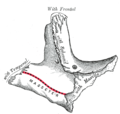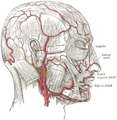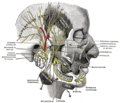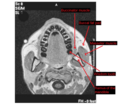Masseter muscle
This article needs additional citations for verification. (May 2015) |
| Masseter | |
|---|---|
mandible | |
| Identifiers | |
| Latin | musculas masseter |
| MeSH | D008406 |
| TA98 | A04.1.04.002 |
| TA2 | 2105 |
| FMA | 48996 |
| Anatomical terms of muscle] | |
In
Structure
The masseter is a thick, somewhat quadrilateral muscle, consisting of three heads, superficial, deep and coronoid. The fibers of superficial and deep heads are continuous at their insertion.
Superficial head
The superficial head, the larger, arises by a thick, tendinous
Deep head
The deep head is much smaller, and more muscular in texture. It arises from the posterior third of the lower border and from the whole of the medial surface of the zygomatic arch. Its fibers pass downward and forward, to be inserted into the upper half of the ramus as high as the coronoid process of the mandible. The deep head of the muscle is partly concealed, anteriorly, by the superficial portion. Posteriorly, it is covered by the parotid gland.
Coronoid head
The coronoid head of the masseter's tendon and muscle fibers run posterolaterally from the coronoid process of the mandible towards the posterior third of the zygomatic arch. Its function is believed to be the retraction of the mandible and the stabilization of the mandibular coronoid process.[6][7]
Innervation
Along with the other three
Function
The action of the muscle during bilateral contraction of the entire muscle is to elevate the mandible, raising the lower jaw. Elevation of the mandible occurs during the closing of the jaws. The masseter parallels the medial pterygoid muscle, but it is stronger and superficial fibres can cause protrusion.
Clinical significance
Examination
To perform an extraoral examination, stand near the patient and visually inspect and bilaterally palpate the muscle. Place the fingers of each hand over the muscle and ask the patient to clench his or her teeth several times.[8]
Pathology
The masseter muscle can become enlarged in patients who habitually clench or grind (with bruxism) their teeth and even in those who constantly chew gum. This masseteric hypertrophy is asymptomatic and soft; it is usually bilateral but can be unilateral. Even if the hypertrophy is bilateral, asymmetry of the face may still occur due to unequal enlargement of the muscles. This extraoral enlargement may be confused with parotid salivary gland disease, dental infections, and maxillofacial neoplasms. However, no other signs are present except those involved in changes in occlusion intraorally such as pain, and the enlargement corresponds with the outline of the muscle. Most patients seek medical attention because of comments about facial appearance, and this situation may be associated with further pathology of the temporomandibular joint.[8]
Finally, the muscle undergoes spasm with
Singers often experience various kinds of masseter tension, which is often treated with transdermal massages or stretches as a vocal warm-up.[9][10]
In other animals
The masseter muscle's positioning is a distinguishing feature of hystricognathous creatures such as mole-rats, where it passes partially through the infraorbital foramen and connects to the bone on the opposite side.
In toothed whales, the masseter muscle, made redundant due to a shift in ingesting food from chewing to swallowing, provides the tissue for acoustic fat bodies, including the melon, used for echolocation.[11]
Additional images
-
Muscles of the head and neck.
-
Dissection, showing salivary glands of right side (Masseter visible at center)
-
Left temporal bone, outer surface
-
Left temporal bone, inferior surface
-
Left zygomatic bone, temporal surface
-
Mandible, outer surface, side view
-
The arteries of the face and scalp.
-
Veins of the head and neck.
-
Mandibular division of the trifacial nerve.
-
Masseter muscle. Deep dissection. Mummification process.
-
An MRI of head with captions for masseter muscle and other structures around it
See also
Notes
- ^ The word masseter (usually /məˈsiːtər/,[1][2][3] sometimes /ˈmæsɪtər/[4]) comes through Neo-Latin from Greek μασᾶσθαι masasthai, "to chew".
References
- ^ Elsevier, Dorland's Illustrated Medical Dictionary, Elsevier.
- ^ Merriam-Webster, Merriam-Webster's Medical Dictionary, Merriam-Webster.
- ^ Houghton Mifflin Harcourt, The American Heritage Dictionary of the English Language, Houghton Mifflin Harcourt, archived from the original on 2015-09-25, retrieved 2015-09-27.
- ^ Wolters Kluwer, Stedman's Medical Dictionary, Wolters Kluwer.
- ISBN 0-03-910284-X.
- S2CID 244844284.
- S2CID 247374798.
- ^ a b Illustrated Anatomy of the Head and Neck, Fehrenbach and Herring, Elsevier, 2012, p. 97
- ^ "Mix it up Monday: Releasing the masseter muscle". 14 December 2015.
- ISBN 978-0878301980.
- .











